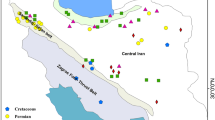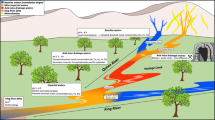Abstract
Gold mining activities generated wastes with high concentrations of arsenic and zinc in the vicinity of Yellowknife, Northwest Territories, Canada. Some of the waste material has been discharged into Yellowknife Bay of Great Slave Lake. Concentrations of arsenic and zinc were determined in sediment cores collected at the depositional areas of Yellowknife Bay. Sedimentation rates were estimated using two different radiometric approaches: the depth profiles of Cs-137 and Pb-210. Geochemical composition of the sediment cores indicated input of similar material into sampling areas over the past 50 years. Age profiles of the sediment constructed from the radionuclides measurements were used to determine historical trends of arsenic and zinc inputs into Yellowknife Bay. The historical record was in good agreement with implemented remedial actions and usage patterns of both elements.
Similar content being viewed by others
References Cited
Allan, R. J., 1979, Heavy metals in bottom sediments of Great Slave Lake (Canada): A reconnaissance: Environ. Geol., v. 3, p. 49–58.
Boyle, R. W., 1960, The geology, geochemistry and origin of the gold deposits of the Yellowknife District. Geol. Survey Can., Memoir 310, Dept. Mines and Technical Surveys Canada, Ottawa, Ontario, p. 193.
Durham, R. W., and S. R. Joshi, 1980, Recent sedimentation rates, Pb-210 fluxes, and particle settling velocities in Lake Huron, Laurentian Great Lakes: Chem. Geol., v. 31, p. 53–66.
Durham, R. W., S. R. Joshi, and R. J. Allan, 1980, Radioactive dating of sediment cores from four contignons lakes in Saskatchewan, Canada: Sci. Total Environ., v. 15, p. 65–71.
Joshi, S. R., 1985a, Recent sedimentation rates and Pb-210 fluxes in Georgian Bay and Lake Huron: Sci. Total Environ., v. 41, p. 219–233.
Joshi, S. R., 1985b, Determination of Thorium-228, Thorium-230, and Thorium-232 in sediments by anion exchange and nuclear spectrometry: Anal. Chem., v. 57, p. 1023–1026.
Kleinbaum, D. G., and L. L. Kupper, 1978, Applied regression analysis and other multivariable methods: MA, USA; Durburg Press, p. 556.
Krishnaswamy, S., D. Lal, J. M. Martin, and M. Maybeck, 1971, Geochronology of lake sediments: Earth Planet. Sci. Lett., v. 11, p. 407–414.
Marshall, K. C., 1979, Biogeochemistry of manganese minerals. In P. A. Trudinger and D. J. Swaine, eds., Biogeochemical cycling of mineral-forming elements: Amsterdam: Elsevier, p. 253–252.
Metcalfe, J. L., and A. Mudroch, 1985, Distribution of arsenic and mercury in zoobenthos from the Shubenacadie River headwater lakes in Nova Scotia: National Water Research Institute Contribution Series No. 85-72, Burlington, Ontario; p. 30.
Moore, J. W., S. J. Wheeler, and D. J. Sutherland, 1978, The effects of metal mines on aquatic ecosystem in the Northwest Territories. II: Giant Yellowknife Mines Limited, Fisheries and Environment Canada, Environmental Protection Service, Report EPS 5-NW-78-9, p. 58.
Mudroch, A., 1985, Geochemistry of the Detroit River sediments: Jour. Great Lakes Res., v. 11, p. 193–200.
Mudroch, A. and T. A. Clair, 1985, The impact of past gold mining activities on the Shubenacadie River headwaters ecosystem: Environment Canada, Inland Waters Directorate, Atlantic Region, IWD-AR-WQB-85-81, p. 195.
Rawson, D. S., 1950, The physical limnology of Great Slave Lake: Jour. Fish. Res. Bd. Canada, v. 8, p. 3–6.
Wallace, R. R. and M. J. Hardin, 1974, Chemical and biological characteristics of seepage from tailing areas at Giant Yellowknife Mines, Ltd. into Great Slave Lake, Northwest Territories in 1974: Environment Canada, Environmental Protection Service Surveillance Report EPS 5-NW-74-1, p. 35.
Wiskel, B. W., L. S. Price, and H. Erkku, 1978, Treatment of Giant Yellowknife Mines effluent for reduction of cyanide and arsenic pilot plant operation at Giant Yellowknife Mines Limited, 1976–1977. Fisheries and Environment Canada, Ottawa, Report, p. 263.
Author information
Authors and Affiliations
Rights and permissions
About this article
Cite this article
Mudroch, A., Joshi, S.R., Sutherland, D. et al. Geochemistry of sediments in the back bay and Yellowknife Bay of the Great Slave Lake. Environ. Geol. Water Sci 14, 35–42 (1989). https://doi.org/10.1007/BF01740583
Issue Date:
DOI: https://doi.org/10.1007/BF01740583




